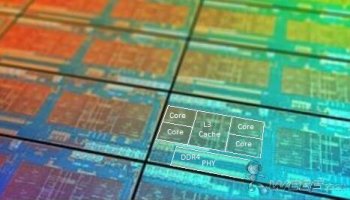Hehe, I was talking about Mainstream i3, i5, i7. And that is because Zen will be offered in 6 and 8 core versions.
If look at AMD's 2015 slides here you'll see that Zen was to initially drop in a "FX" class
http://www.fudzilla.com/news/40627-first-amd-zen-chips-may-not-be-quad-core-parts
( second slide above).
I suspect that this (from article linked above )
".. t appears AMD will be initially focused on bringing back some high-end desktop (HEDT) market share from Intel’s stagnant performance numbers. ..."
Only not really aiming at these 6-8 core models more so at the 6700 (capped at 4) and the kneecapped 6 core model at the bottom (e.g. new i7 6800K capped at 28 PCIe lanes) .
They are going to save effort/expensive by reusing the APU socket AM4, but I suspect the addition 4 cores are going to come at expense of the iGPU.
If look at the floor plan of Bristol Ridge ( which is AM4 socket solution )

http://www.anandtech.com/show/10362/amd-7th-generation-apu-bristol-ridge-stoney-ridge-for-notebooks
Then can get to double the amount of x86 cores by chopping the GPU in half and consuming one of those halves. If mostly aiming at the HEDT market then there likely will be 1-2 discrete GPUs in the standard PCI socket(s) anyway. The iGPU would be either be for computational only for main RAM based modeling or lightweight VGA/DVI socket duties. Putting hopes on DX12/Mantle like workloads to drive into more threads which the additional cores may help with while primarily focused on gaming for which the limited bandwidth to the GPU cards is tip-toed around in the normal desktop market. ( x16 sliced into two x8 backstopped by SLI/Crossfire is pretty standard stuff).
The initial Zen coming in at higher than mainstream Core i price point but under the Extrme/E5 1600 levels. AMD has to move their average selling price higher to survive. The ones which the much higher GPU budget likely will have just one of the 4 core "slices". (Hence in the same boat as Intel's mainstream offerings).
From an Apple perspective though .... a diminished iGPU isn't going to cut it. In the iMacs they aren't looking for a dGPU in most of the line up. In the future mini's even more so. For the Mac Pro this "mainstream" I/O bandwidth isn't going to work.
If Zen is decent then probably will get some movement of Intel to move the E5 1620-30 to fully 6 cores and non throttled clock speeds in next generation. ( the pricing might come back a bit or at very least not go up again. as it appears to have done for v4. ). At best AMD can stop the pricing climb . If a future iteration of Zen does even more better may see some reversal, but neither AMD nor Intel wants to see a "race to the bottom" on x86 package pricing.
Of course, I do not contradict anything what you have written about technology behind this. This is in addition to what you have written. But without Zen being good, Intel would not even think about putting 8 or even 6 cores on mainstream CPUs. You know, money from customers smells really good.
If AMD can bring 6-8 and outpace Intel on iGPU all on approximately the same transistor budget, then there is a threat. IF AMD throws the iGPU under the bus to get to 6-8 cores then there is only a highly limited threat here. Highly doubtful Intel will panic if that is the case. Much of weakness in the gap bettween 6700K and 6800K is Intel's marketing kneecapping the current designs to enhance market segmentation. It should be easy enough to just take that artificial throttle off.
Last edited:



